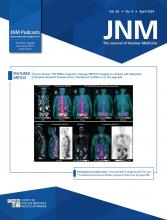REPLY: We thank Drs. Polosa, Spicuzza, and Palmucci for their interest and comments on our study. The team’s comments highlight evidence supporting traditional combustible cigarettes as a proinflammatory phenotype and the potential of electronic cigarettes for harm reduction as a tool for smoking cessation. Harm reduction represents an important strategy in public health, because smoking combustible nicotine cigarettes remains the largest preventable cause of death worldwide (1,2).
In our innovative pilot study, we found increased radiotracer binding of 18F-6-(1/2)(2-fluoropropyl)-4-methylpyridin-2-amine (18F-NOS) in the lungs of electronic cigarette users compared with traditional combustible cigarette users (3). This unanticipated finding led us to conclude that electronic cigarette use leads to unique physiologic changes in the lungs, distinct from combustible cigarettes, including relatively increased inflammation in younger, otherwise healthy individuals. We neither concluded nor implied that vaping was more harmful than combustible cigarettes nor measured metrics of harm such as death or contribution to other diseases such as cancer, heart disease, or stroke.
Although there is evidence that electronic cigarettes can achieve cigarette quit rates superior to those for the nicotine patch (4), the long-term public health effects of electronic cigarettes, first introduced in the United States and the European Union in 2006, remain unclear (1,5). Given the decades of public health research documenting the various adverse outcomes that manifest after years of combustible cigarette smoking, including chronic obstructive pulmonary disease, cancer, and heart disease (6–8), it is important to acknowledge that electronic cigarettes are not harmless and could have long-term adverse health effects that are distinct from those associated with combustible cigarette use.
Electronic cigarettes are not unique to individuals trying to quit or who have quit smoking cigarettes. The Centers for Disease Control and Prevention report that 36.9% of individuals who vape also smoke combustible cigarettes and that 23.6% have never smoked combustible cigarettes, with the remaining 39.5% being former smokers (9). Electronic cigarette use among youth in the United States is alarming, with an estimated 2.14 million high school students and 380,000 middle school students reporting use (10). A harm reduction strategy for most of these individuals is not applicable; there is only the potential for harm. Thus, our study aimed to examine those who exclusively vape.
How electronic cigarette use alters cardiopulmonary physiology and the local pulmonary cellular milieu remains unclear. In agreement with our study, there is growing evidence that electronic cigarette use results in a proinflammatory phenotype (11–15). We carefully excluded subjects with asthma or allergies and those taking medications that could temper inflammation. Additionally, we did not observe a decreased PET signal in conventional smokers or suggest that combustible cigarette use results in diminished pulmonary inflammation.
With the epidemic rates of electronic cigarette use among youth continuing to rise and most adult users not using electronic cigarettes for smoking cessation, the long-term public health consequences of this relatively new behavior cannot be dismissed because of the lack of long-term data.
Footnotes
Published online May 11, 2023.
- © 2023 by the Society of Nuclear Medicine and Molecular Imaging.







